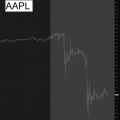This article provides an in-depth examination of the fundamental outlook for gold prices in the second quarter, examining critical market themes and key drivers that could play a pivotal role in shaping the precious metal’s trajectory. For a holistic view that includes technical analysis, download the full Q2 forecast.
Recommended by Diego Colman
Get Your Free Gold Forecast
Market Recap: New Record in the Books
Gold achieved an extraordinary feat in the first quarter, surpassing its previous record and shattering the $2,200 per ounce barrier. This rally was fueled primarily by investor anticipation of a dovish shift in the outlook for monetary policy. After a series of aggressive rate hikes in 2022 and 2023 across much of the developed world, investors expect the Fed and other key central banks to begin removing restriction in the upcoming months as economic growth and inflation moderate.
With much of the projected transition to a looser stance already priced in into bullion’s valuation, the scope for upward movement may be constrained in the future, particularly considering the 17% increase already observed in the past six months. For substantial material gains, the Federal Reserve would need to adopt a more dovish posture- something that seems improbable given recent guidance and growing inflation risks.
Presently, investors anticipate about 75 basis points of easing from the FOMC in 2024. If the FOMC were to delay action due to stubborn prices pressures and if expectations regarding its policy roadmap were to shift towards a more hawkish direction, gold could be in for a turbulent ride. Generally speaking, gold tends to benefit from lower Treasury yields and a weaker U.S. dollar, conditions often associated with the Fed reducing borrowing costs.
The following below shows current FOMC meeting probabilities for the next nine meetings.
FOMC meeting probabilities
Source: CME Group, Prepared by Diego Colman
Looking to level up your gold trading game? Download our exclusive “How to Trade Gold” guide for free and gain access to expert insights and strategies.
Recommended by Diego Colman
How to Trade Gold
Beyond the Fed: Geopolitics, Central Bank Demand
Global interest rates will not be the only factor influencing gold’s trend. Lingering conflicts, notably those related to the Russia-Ukraine war, which have already built up a geopolitical premium in the precious metal, could emerge once again as a more significant pillar of support if tensions escalate in the upcoming quarter.
Additionally, strong physical gold purchases by central banks are likely to be another source of market strength. By way of context, in 2022 and 2023, central banks collectively acquired over 1,000 tonnes of gold each year, setting a historic pace, with the Central Bank of Turkey and the People’s Bank of China being two active buyers.
Central banks have been buying gold at a record pace because of its safe-haven qualities in times of turmoil, its reputation as a stable store of value, and its usefulness for diversification. As global power dynamics shift and U.S. dominance becomes less certain, central banks have been strategically reallocating their reserves, moving away from heavy reliance on the U.S. dollar, which has traditionally formed the bulk of their holdings.
Although comprehensive data for 2024 remains somewhat limited, January’s central bank acquisitions of 39 tonnes and projections from the World Gold Council indicate that demand could continue to be robust throughout the year. This could act as a buffer in the event of a bearish reversal in prices, thus limiting potential losses in a downward correction.
Central Banks gold buying
Source: Metals Focus, Refinitiv GFMS, ICE Benchmark Administration, World Gold Council
The Outlook: Neutral with a Watchful Eye
The second quarter may see a period of consolidation for gold, following its impressive gains in the year’s first months. With that in mind, a dramatic price surge in either direction is unlikely barring an unexpected shift in global inflation dynamics and the monetary policy outlook.
Investors should closely monitor economic data, central bank communication, and global geopolitical developments. These factors will provide important clues about the precious metal’s trajectory in the coming months. Later in the year, as the November U.S. presidential election draws near, heightened volatility, customary during such periods, may potentially be a tailwind for gold prices, traditionally considered a defensive investment in times of uncertainty. However, this theme is not expected to dominate the market in the second quarter just yet.
| Change in | Longs | Shorts | OI |
| Daily | -6% | -6% | -6% |
| Weekly | -8% | 16% | 5% |




